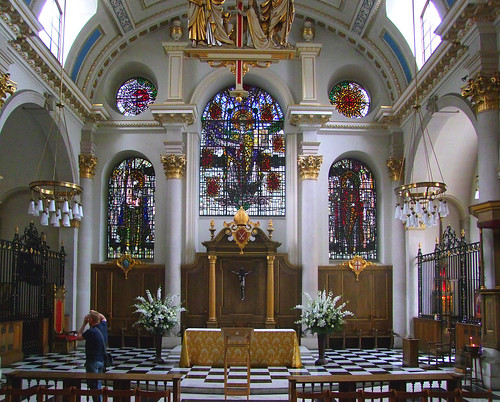
 |
| An occasional saunter
through the churches of the Square Mile |
| home | index | map | latest | about this site | resources | small print | simonknott.co.uk | norfolkchurches.co.uk | suffolkchurches.co.uk |
| St Mary le Bow |
 |
One of the best-known of the City churches, standing proudly among the modern shops and offices of Cheapside with its former burial ground now a square to the west of it. The medieval church was also well-known, its great tower a prominent sight to anyone approaching the city. It was lit up with lanthorns at night. And the bells, of course, are also some of the City's best-known, remembered for supposedly calling, in about the year 1390, the young Richard Whittington back to London as he slinked sorrowfully out of town up Highgate Hill: Turn again, Whittington, once Lord Mayor
of London! Richard Whittington was a
fabulously wealthy mercer, an early capitalist who
benefited from the radical restructuring of the English
economy in the years after the Black Death. In fact, he
was Lord Mayor of London four times - in 1407, he was
Lord Mayor of both London and Calais at the same time -
and financed a number of public projects, such as
drainage systems in poor areas of medieval London, and a
hospital ward for unmarried mothers. He passed a law
prohibiting the washing of animal skins by apprentices in
the River Thames in cold, wet weather. In the absence of
heirs, Whittington left £7,000 in his will to charity,
equivalent to about £300 million in today's money. Among
other things, it was used to rebuild Newgate Prison and
Newgate, build the first library in the Guildhall, repair
St Bartholomew's Hospital and install London's first
public drinking fountains. Oranges and lemons, say the
bells of St. Clement's And to be born within the sound of
Bow bells is the definition of being a cockney. So here
we have a church which was central to the Myth of London
long before the Great Fire and Sir Christopher Wren came
along. When he did, it was to rebuild the burned-down
church on spectacular lines, the most obvious of which is
the tower, perhaps the City's best, thoroughly assured in
its Classical self-confidence. Wayland Young notes that
Wren used as a foundation for it a Roman causeway he
found eighteen feet below ground. He also excavated under
the medieval ruins a vaulted crypt, and because of the
Roman bricks used in the arches he assumed that this was
Roman too. As Young points out, it is in fact 11th
Century, and probably the arches gave St Mary its
epithet, for St Mary de Arcubus can be
translated as St Mary of the Bow. Towards the end of this period King also took on the reconstruction of Little Walsingham church in Norfolk, which had been gutted by fire, and there are obvious lessons there learned here, not least that John Hayward was a good man to have on the job. Both churches are full of Festival of Britain confidence, the rich simplicity of post-war Anglo-catholicism, sure of itself but not yet dogmatic. And yet there is never any doubt standing inside St Mary le Bow that this is a Wren church, a civic church with a sense of dignity and gravitas. As, conversely, there is a medieval spirit at King's contemporarily refurbished Little Walsingham church. It was a tremendously successful result for both. Not long after photographing this
church, and being buoyed up again by its sheer feelgood
factor, I was excited to find a copy of Charles Cox's English
Church Fittings, Furniture and Accessories in a
Suffolk book shop. A large hardback volume published by
Batsford in 1923, fairly rare nowadays, it was a seminal
work for those looking to restore some of the damage
caused by Victorian enthusiasm. Turning to the front of
it, I found Laurence King's bookplate. It had been his
copy. I leave you, the reader, to decide quite how
excited I was as I carried the book home.
Commission
from Amazon.co.uk supports the running of this site |
| home | index | map | latest | about this site | resources | small print | simonknott.co.uk | norfolkchurches.co.uk | suffolkchurches.co.uk |
 |
| An occasional saunter
through the churches of the Square Mile |